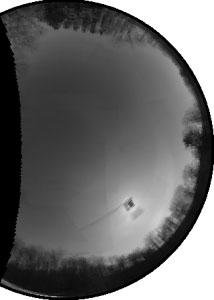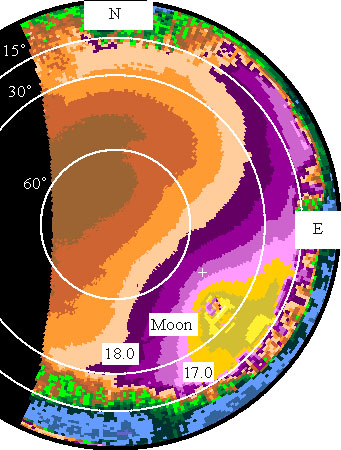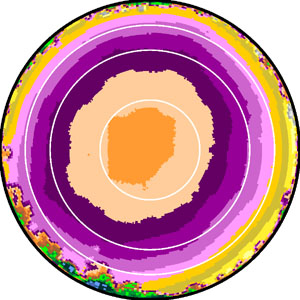One of my biggest uncertainties in predicting the visibility of asteroid 2006 VV2 was guessing how much the proximity of a nearly full Moon would hurt. Just how bright is the sky 16 degrees from a 98%-illuminated Moon? More broadly, how does an otherwise dark location at full Moon compare to an urban site at new Moon? These questions have been studied by professional astronomers — see, for instance, the utilities VISLIMIT.BAS and OCCVIS.BAS, both by Bradley E. Schaefer, in our repository of BASIC programs. But I also wanted to measure the effect myself, in terms familiar to me.

Tony Flanders
I found a spot where less than half the sky was obscured by trees, and took a series of 14 shots covering the eastern (unobscured) part. (Each shot took 8 seconds at f/2.8, ISO 200.) Then I brushed the dust off the software that I use to analyze such photos, which I described in S&T February 2006, page 99. The raw composite is shown at right, with skyglow represented in grayscale. You can see the shade that I used to block the Moon's direct light, an artifact below where I inadvertently moved the shade, and trees along the horizon. As you can see, the sky is quite bright right near the Moon, and especially below it. This highlights a comment Alan MacRobert made to me when we were searching (unsuccessfully) for Comet McNaught during daylight hours: it makes a huge difference whether your target is higher or lower in the sky than the Sun is. Presumably, the same is true of the Moon. But directly opposite the Moon, the sky is surprisingly dark, especially high above the horizon.

Tony Flanders
Here's the same thing color-coded to show skyglow in magnitude per square arcsecond. For instance, magnitude 18.0 per square arcsecond, or 18.0 mpss, is the brightness that a square arcsecond of sky would have if the light from an 18th-magnitude star were spread evenly across it. The lower the mpss, the brighter the sky is. The browns represent 19-18 mpss, purples 18-17 mpss, and yellows 17-16 mpss, all in quarter-magnitude increments. The little purple rectangle is the shade that I used to obscure the Moon, and the plus sign above represents the approximate position of the asteroid, in skyglow a tad brighter than 17.5 mpss. The darkest spot in the sky is nearly 19.0 mpss, which is dark enough to see the brightest parts of the Milky Way fairly easily. For comparison, 22.0 mpss is considered to be the Holy Grail of sky darkness, the limit set by natural light sources such as airglow and the zodiacal light.

Tony Flanders
How does this compare to urban light pollution? The diagram at right shows Danehy Park, the brightest of my customary observing sites, at its absolute darkest — at 4:30 a.m. on a night of excellent transparency, in late summer, when the trees are full of leaves. All in all, the sky is significantly brighter than at an otherwise dark site near full Moon. That's particularly true if you consider only the portion of the sky more than 30 degrees above the horizon, where most telescopic observing takes place. But what's most striking of all is how different the distribution of light is in these two situations. In the city, light wells up from the horizon in all directions, though it's significantly brighter to the southeast, toward downtown Boston. But the Moon's light comes from above, and many parts of the horizon are actually darker than the area right around the Moon.
Why does this matter? Well, I have tons of empirical data on the visibility of deep-sky objects and faint stars from Danehy Park. I rarely view targets like that at full Moon, but sometimes there isn't a choice. When an asteroid comes zipping by or a supernova goes off in a nearby galaxy, you can't always wait for the Moon to get out of the way. And if I can draw a correspondence between moonglow and light pollution, then I have a way to predict what I'll see on those rare occasions when I do attempt deep-sky observing at full Moon.
 1
1
Comments
Stephen
August 15, 2007 at 1:53 pm
I do much of my observing from my driveway - nick named the Mercury Vapor Observatory. The Moon is just not a significant factor. If it's out, sometimes i'll look at it. I don't cringe when a car turns the corner and shines its headlights right at me. I hardly notice. On the down side, i mostly know the Little Dipper from sky charts. And the last meteor i was able to see caused the dinosaur extinction.
The advantages of the site are that the ten year old can sleep while i observe. It doesn't take long to set up or pack up. It doesn't take any time at all for the eyes to dark adapt (what's that?). If i've forgotten some item, well it's just inside. If it's cold out, i can just pop back into the house. The scope can cool while i warm. I don't need a flashlight to read charts or find contact lenses that fall on the ground. Red flashlights aren't needed for anything.
And nebulae are as good as they are anywhere. Last summer, on a very clear night, M16 - the Eagle Nebula was absolutely awesome. Yes, it was in a part of the sky right between two of the grocery store parking lot flood lights that lie across the street. But an Oxygen 3 filter doesn't pass that wavelength. A shroud over my head and eyepiece keeps out most other light.
It is rare, but the other night, i even spotted a couple galaxies. Virgo was high in the sky.
You must be logged in to post a comment.
You must be logged in to post a comment.